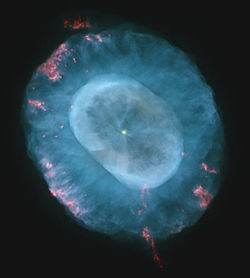NGC 7662
| Emission nebula | |
|---|---|
| Planetary nebula | |
 | |
| Observation data: J2000 epoch | |
| Right ascension | 23h 25m 53.832s[1] |
| Declination | +42° 32′ 05.84″[1] |
| Distance | 5,730 ± 340[1] ly |
| Apparent magnitude (V) | 8.3[2] |
| Apparent dimensions (V) | 32″ × 28″[2] |
| Constellation | Andromeda |
| Physical characteristics | |
| Radius | 0.8[citation needed] ly |
| Designations | PK 106-17 1, GCRV 14695, PN ARO 20, Blue Snowball Nebula, Snowball Nebula, Caldwell 22[3] |
NGC 7662 is a planetary nebula located in the northern constellation Andromeda. It is known as the Blue Snowball Nebula, Snowball Nebula, and Caldwell 22. This nebula was discovered October 6, 1784 by the German-born English astronomer William Herschel. In the New General Catalogue it is described as a "magnificent planetary or annular nebula, very bright, pretty small in angular size, round, blue, variable nucleus". The object has an apparent visual magnitude of 8.3 and spans an angular size of 32″ × 28″.[2] Parallax measurements give a distance estimate of 5,730 ± 340 ly (1,757 ± 103 pc).[1]
NGC 7662 is a popular planetary nebula for casual observers. A small telescope will reveal a star-like object with slight nebulosity. A 6" telescope with a magnification around 100x will reveal a slightly bluish disk, while telescopes with a primary mirror at least 16" in diameter may reveal slight color and brightness variations in the interior.[4]
This nebula has an elliptical shape with a triple-shell structure. The brightest is the main shell, which spans 12″ × 18″. This is surrounded by a fainter outer shell, which has an elliptical form. Both shells are enclosed by a faint, circular halo,[5] some 134″ in diameter. The two shells can be modeled as prolate spheroids, with the inner shell having the greater elongation, a major axis tilt of 50° to the line of sight, and a hull thickness of ~2.5″.[6] Several knots and a jet-like structure are visible, which display emission lines and low ionization. Based on the expansion rate, the estimated age of the nebula is 3,080 years.[5]
The central star of the planetary nebula is a subdwarf O star with a spectral type of sdO.[7] The best fit model for this star gives an effective temperature of 100 kK, with 5,250 times the luminosity of the Sun[5] and 60.5% of the Sun's mass.[6] X-ray emission from the nebula is being generated by the stellar wind from this star striking previously ejected matter.[2]
Image gallery
- Hubble Space Telescope image of NGC 7662[8]
See also
- NGC 2022, which resembles NGC 7662
- NGC 2392
- NGC 3242
- List of NGC objects
- Planetary nebulae
References
- ^ a b c d Brown, A. G. A.; et al. (Gaia collaboration) (2021). "Gaia Early Data Release 3: Summary of the contents and survey properties". Astronomy & Astrophysics. 649: A1. arXiv:2012.01533. Bibcode:2021A&A...649A...1G. doi:10.1051/0004-6361/202039657. S2CID 227254300. (Erratum: doi:10.1051/0004-6361/202039657e). Gaia EDR3 record for this source at VizieR.
- ^ a b c d O'Meara, Stephen James (2016). Deep-Sky Companions: The Caldwell Objects. Cambridge University Press. pp. 105–108. ISBN 9781316033531.
- ^ "NGC 7662". SIMBAD. Centre de données astronomiques de Strasbourg. Retrieved 2007-04-10.
- ^ Burnham, Robert (2013). Burnham's Celestial Handbook, An Observer's Guide to the Universe Beyond the Solar System. Vol. 1. Dover Publications. p. 157. ISBN 9780486319025.
- ^ a b c Barría, D.; Kimeswenger, S. (October 2018). "HST/WFPC2 imaging analysis and cloudy modelling of the multiple-shell planetary nebulae NGC 3242, NGC 6826, and NGC 7662". Monthly Notices of the Royal Astronomical Society. 480 (2): 1626–1638. arXiv:1807.01787. Bibcode:2018MNRAS.480.1626B. doi:10.1093/mnras/sty1796.
- ^ a b Guerrero, Martín A.; et al. (October 2004). "Physical Structure of Planetary Nebulae. II. NGC 7662". The Astronomical Journal. 128 (4): 1705–1710. arXiv:astro-ph/0407029. Bibcode:2004AJ....128.1705G. doi:10.1086/423913. S2CID 7142085.
- ^ González-Santamaría, I.; et al. (2021). "Planetary nebulae in Gaia EDR3: Central star identification, properties, and binarity". Astronomy & Astrophysics. 656: A51. arXiv:2109.12114. Bibcode:2021A&A...656A..51G. doi:10.1051/0004-6361/202141916. S2CID 237940344.
- ^ "Hubble picture of NGC 7662". The Hubble European Space Agency Information Centre. 2007-09-27.
External links
 Media related to NGC 7662 at Wikimedia Commons
Media related to NGC 7662 at Wikimedia Commons- NGC 7662 on WikiSky: DSS2, SDSS, GALEX, IRAS, Hydrogen α, X-Ray, Astrophoto, Sky Map, Articles and images

![Hubble Space Telescope image of NGC 7662[8]](https://upload.wikimedia.org/wikipedia/commons/thumb/6/6a/Ngc7662hst.jpg/159px-Ngc7662hst.jpg)